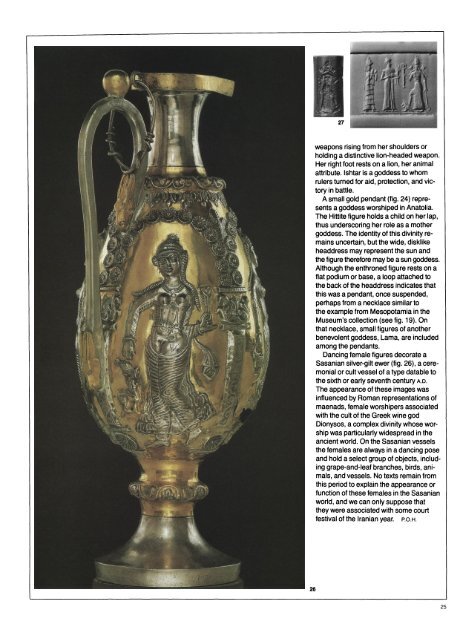Ancient Near Eastern Art: The Metropolitan Museum of Art Bulletin, v ...
Ancient Near Eastern Art: The Metropolitan Museum of Art Bulletin, v ...
Ancient Near Eastern Art: The Metropolitan Museum of Art Bulletin, v ...
Create successful ePaper yourself
Turn your PDF publications into a flip-book with our unique Google optimized e-Paper software.
2/<br />
weapons rising from her shoulders or<br />
holding a distinctive lion-headed weapon.<br />
Her right foot rests on a lion, her animal<br />
attribute. Ishtar is a goddess to whom<br />
rulers turned for aid, protection, and victory<br />
in battle.<br />
A small gold pendant (fig. 24) represents<br />
a goddess worshiped in Anatolia.<br />
<strong>The</strong> Hittite figure holds a child on her lap,<br />
thus underscoring her role as a mother<br />
goddess. <strong>The</strong> identity <strong>of</strong> this divinity remains<br />
uncertain, but the wide, disklike<br />
headdress may represent the sun and<br />
the figure therefore may be a sun goddess.<br />
Although the enthroned figure rests on a<br />
flat podium or base, a loop attached to<br />
the back <strong>of</strong> the headdress indicates that<br />
this was a pendant, once suspended,<br />
perhaps from a necklace similar to<br />
the example from Mesopotamia in the<br />
<strong>Museum</strong>'s collection (see fig. 19). On<br />
that necklace, small figures <strong>of</strong> another<br />
benevolent goddess, Lama, are included<br />
among the pendants.<br />
Dancing female figures decorate a<br />
Sasanian silver-gilt ewer (fig. 26), a ceremonial<br />
or cult vessel <strong>of</strong> a type datable to<br />
the sixth or early seventh century A.D.<br />
<strong>The</strong> appearance <strong>of</strong> these images was<br />
influenced by Roman representations <strong>of</strong><br />
maenads, female worshipers associated<br />
with the cult <strong>of</strong> the Greek wine god<br />
Dionysos, a complex divinity whose worship<br />
was particularly widespread in the<br />
ancient world. On the Sasanian vessels<br />
the females are always in a dancing pose<br />
and hold a select group <strong>of</strong> objects, including<br />
grape-and-leaf branches, birds, animals,<br />
and vessels. No texts remain from<br />
this period to explain the appearance or<br />
function <strong>of</strong> these females in the Sasanian<br />
world, and we can only suppose that<br />
they were associated with some court<br />
festival <strong>of</strong> the Iranian year. P.O.H.<br />
26<br />
25

















